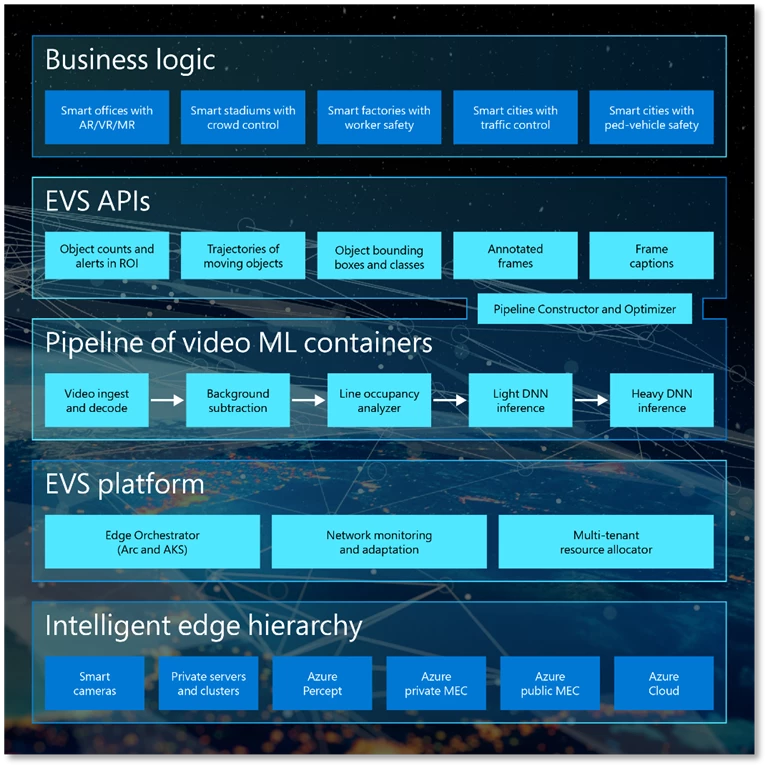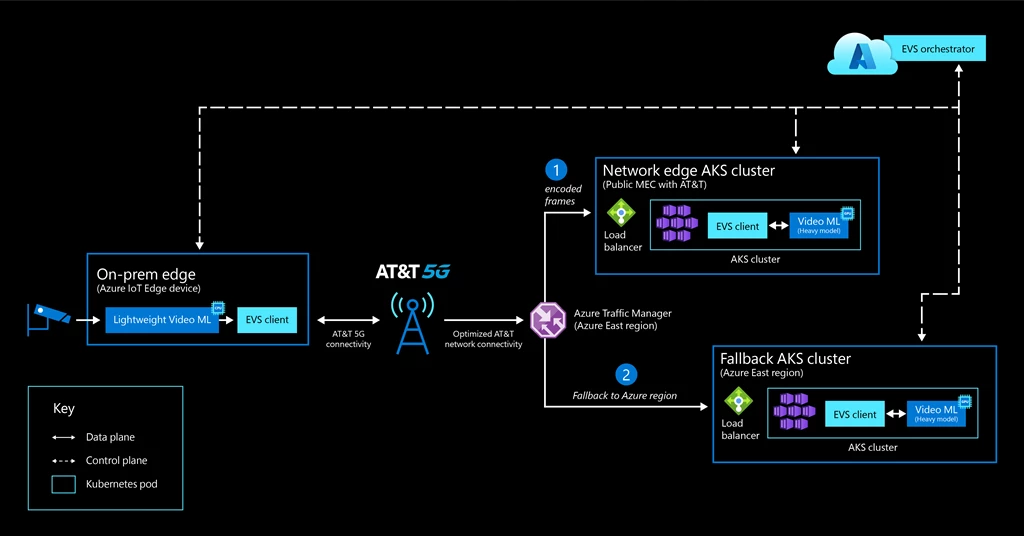Management and Governance, Networking, Partners, Traffic Manager
Microsoft and AT&T demonstrate 5G-powered video analytics
Posted on
4 min read
In November 2021, Microsoft and AT&T announced the launch of Azure public MEC (multi-access edge compute) with a site in Atlanta, Georgia. The Azure public MEC solution enables low-latency applications at the edge of the mobile operator’s network, providing Azure compute services integrated with 5G connectivity. Azure public MEC is designed to run AI and machine learning workloads that require intensive compute and low latency network. The access to these resources is over high-quality 5G connections from phones, smart cameras, IoT devices, and other equipment. Enterprises and developers can build and run these low-latency applications and manage their workloads using the same tools they are using to run applications in the Azure public cloud.
To light up new compelling applications with Azure public MEC that benefit from low latency 5G connectivity, we are making available a video analytics library under the umbrella of Edge Video Services.
Edge Video Services
Edge Video Services (EVS) is a Microsoft platform for developing video analytics solutions that can be deployed on Azure public MEC. For example, consider some smart city applications like our Vision Zero work with the City of Bellevue, which enabled a new generation of real-time traffic flows leading to substantial improvements in the day-to-day lives of commuters. Similarly, real-time video analytics can make cities safer by controlling traffic lights for situations such as allowing a person in a wheelchair to safely cross the street. A related application, which we demonstrated at Hannover Messe 2016, integrated an early version of EVS into traffic light cameras and those in self-driving cars to analyze videos to help reduce accidents and fatalities. Other new applications that are coming soon include improving transportation systems, monitoring air quality, street lighting, smart parking, crowd management, and emergency management. Beyond smart cities, EVS can provide modern smart enterprises with end-to-end experiences with video analytics for mixed reality as a natural component of 5G network solutions. Additional examples include managing machines and robots in connected factories, handling customer demands and services in retail stores and restaurants or tracking pedestrian traffic in sports arenas.

Figure 1: EVS architecture stack.
As shown in Figure 2 below, 5G compute infrastructure has a hierarchy of intelligent components including Azure Percept devices, Azure private MEC, and Azure public MEC. EVS integrates with all of these solutions and provides these features:
- Inter-edge orchestrator to manage network traffic involving multiple public MECs. It deploys application containers across the edge hierarchy for high availability and fault tolerance.
- Network monitoring and adaptation to continuously monitor the dynamic wireless and wired network connections, adapting application demands accordingly.
- Dynamic resource allocation for video machine learning containers. This adapts based on the load generated from the mobile network and the workloads deployed in the on-premises edge location.
Smart cities deployment at Azure public MEC with AT&T in Atlanta
Working with AT&T, Microsoft demonstrated the value of EVS on the Azure public MEC connected to the AT&T’s 5G network in Atlanta. The setup consisted of an on-premise edge device, managed by Azure IoT Hub and an Azure Kubernetes cluster as shown in the diagram below.

Figure 2: Azure public MEC and AT&T deployment.
The EVS orchestrator places the various containers across the on-premises edge and Azure public MEC. This split execution requires only lightweight compute power on-premises, and also removes the need to provision high bandwidth connectivity out of the on-premises edge.
In our Atlanta deployment, we demonstrated EVS’s split architecture, with lightweight execution at the on-premises edge. It transferred 230MB of data over the 5G link out of the on-premise edge over 24 hours, by contrast, 9.5GB of data would have been sent if all the encoded video were transferred out. In other words, EVS reduced the network utilization by 42x. This network saving was obtained with a CPU-only edge on-premises with no loss in accuracy. Our measurements also showed that network latencies to the Azure public MEC were about 6x lower at the median compared to the nearest Azure region, which translated to faster responses for the application.
EVS is integrated with AT&T’s network APIs to obtain real-time information about the 5G network. As a result, EVS adapts the amount of traffic transferred between the edges, depending on any fluctuations to the latency and bandwidth of the 5G link. EVS uses Azure Traffic Manager to support automatic failover for the Azure public MEC to the nearest Azure region, thus ensuring no disruption to the video application. When failing over to the Azure region, EVS adapts to the changed and increased latency by adjusting the amount of traffic sent out of the on-premises edge via changes to the encoder and machine learning model parameters with minimal impact on application accuracy. EVS is also cognizant of other containers executing at the edges and can elastically scale up or down its compute requirements.
EVS on Azure public MEC: Try it out today
For your video scenarios, we encourage you to try out EVS on Azure public MEC with your own on-premises edge devices. The reference architecture and instructions are available in our GitHub repository. The repository also includes a sample video of cars entering a parking lot that you can use to test EVS for counting cars. To submit feedback about EVS, please email to evs-support@microsoft. Please note this is only for submitting feedback, you will not be contacted.